Physical Address
304 North Cardinal St.
Dorchester Center, MA 02124
Acute viral hepatitis 402
Chronic viral hepatitis 411
Clinical features 411
Multiple chronic viral infections 412
Pathological features 413
Differential diagnosis of chronic hepatitis 418
Semiquantitative scoring in chronic hepatitis 419
Assessment of concomitant disease processes 424
Premalignant and malignancy-associated changes 424
Changing role of liver biopsy in chronic viral hepatitis 425
Individual types of viral hepatitis 425
The subject of this chapter is the pathological consequences of infection with hepatotropic viruses. These viruses form a group of diverse agents that utilize liver tissue as a site of replication and major pathological injury. Hepatotropic viruses include five biologically unrelated viruses A, B, C, D and E. All are responsible for hepatitis, which is generally classified by viral type ( Table 6.1 ). Viral hepatitis can also be identified by the duration of infection and the clinicopathological syndrome that develops ( Box 6.1 ). Hepatitis B, C, D, and E can become chronic.
| Viral agents | Characteristics |
|---|---|
| Hepatitis A (HAV) | RNA picornavirusSporadic or epidemic occurrence with faecal–oral transmission, resulting in acute disease only |
| Hepatitis B (HBV) | DNA hepadnavirusSporadic or endemic occurrence through sexual, perinatal and parenteral transmissionChronic disease persists in 5% of adults and up to 90% of infants.Chronic infection is associated with hepatocellular carcinoma. |
| Hepatitis C (HCV) | RNA flavi-like virusSporadic occurrence with parenteral transmissionPerinatal and sexual spread are less common.Chronic disease develops in 75–85% of persons infected. Cirrhosis is associated with hepatocellular carcinoma. |
| Hepatitis D (HDV) | RNA-defective virusSporadic or endemic disease occurs as co-infection with HBV.Transmission is parenteral and sexual.Chronic disease is seen in patients with chronic HBV infection.HDV worsens the clinical severity of HBV infection. |
| Hepatitis E (HEV) | RNA virus, Hepeviridae familySporadic or epidemic occurrence; endemic in areasTransmission is faecal–oral, resulting in acute disease. Chronic hepatitis is reported in immunosuppressed patients.Mortality rate is 25% in pregnant women. |
Subclinical/anicteric
Symptomatic/icteric
Fulminant
Cholestatic
Atypical presentation in immunosuppressed patients (including fibrosing cholestatic hepatitis)
Acute on chronic
Asymptomatic without hepatocyte necrosis
Chronic infection with hepatic injury, compensated or uncompensated
Compensated chronic hepatitis with cirrhosis
Decompensated chronic hepatitis with cirrhosis
Chronic post-transplant
Although some pathological features are unique to the type of virus responsible for infection, many aspects of the pathological injury and clinical progression are common to multiple types of hepatotropic viral infection.
All hepatotropic viruses are associated with clinical features of acute disease. All but hepatitis A virus (HAV) induce chronic infections. Occurrence of acute viral hepatitis may be sporadic or epidemic. Transmission of HAV and hepatitis E virus (HEV) infections is usually by the faeco–oral route through contaminated food or water. Alternatively, hepatitis B virus (HBV) and hepatitis C virus (HCV) transmission may be through sexual contact or parenteral exposure, such as by intravenous drug use, blood transfusion or occupational needlestick exposure.
The acute infection is often subclinical and usually anicteric in childhood. Symptoms are more frequently observed in adults although they are nonspecific and not readily identifiable as related to viral hepatitis. Common symptoms include fatigue, anorexia and nausea in the early stages, followed by dark urine and jaundice with increasing severity and duration. Right upper quadrant abdominal pain or discomfort, arthritis, urticaria, pruritus and low-grade fever may be present. In patients without jaundice, the symptoms may be mistaken for gastrointestinal (GI) viral infection or another nonspecific viral syndrome.
The severity of acute viral hepatitis may vary from a mild asymptomatic infection to fatal acute liver failure. The latter is characterized clinically by the development, within 26 weeks of the onset of clinical illness, of abnormal coagulation with an international normalized ratio (INR) ≥1.5 and the presence of hepatic encephalopathy in a patient with no pre-existing liver disease , and pathologically by massive or severe hepatocyte necrosis. The terms ‘fulminant hepatic failure’ and ‘subacute hepatitis’ or ‘subacute hepatic necrosis’ were used to describe serious injury developing before or after 8 weeks of illness. This distinction is currently used less now because it does not provide actionable prognostic information. Defining the cause of the acute hepatitis and the presence of comorbidities may link prognosis to a patient's presentation. In patients with acute viral hepatitis, the surviving parenchyma may be characterized by varying degrees of regeneration. Nodular hyperplasia, two-cell-thick hepatocyte plates between sinusoids and mitotic figures within hepatocytes may indicate liver cell regeneration and a potential for recovery. Serum markers of patient prognosis in fulminant hepatic failure are evolving and include new better markers than alpha fetoprotein, as Gc-globulin and troponin levels. Measures of hepatic synthetic capacity such as factor VII and computed tomography-derived liver volume may also be prognostic. Death may result from complications of infection or renal failure rather than from hepatic synthetic dysfunction directly.
Portal hypertension and ascites are typically associated with chronic liver disease and rarely develop in patients with acute hepatitis. These complications, when they do occur in acute disease, may be the result of hepatocyte loss and consequent collapse of the sinusoidal network.
Acute viral hepatitis is characterized by injury to hepatocytes and is identified by a marked elevation of serum aminotransferase (transaminase) activities. Increases in serum transaminase values precede a rise in bilirubin and may peak before the development of jaundice. Jaundice, in the presence of significant elevation of transaminase values, indicates a severe degree of liver injury. Jaundice may persist at lower levels of serum bilirubin during recovery because of bilirubin that is conjugated to albumin in tissue, particularly if hyperbilirubinaemia has been prolonged. This bilirubin and albumin complex has been termed ‘delta bilirubin’. There may also be a decrease in hepatic synthesis of clotting factors that, if severe, is reflected in prolonged prothrombin time (PT) and elevated INR.
Cholestatic hepatitis is a clinical variant of acute viral hepatitis in which biliary dysfunction predominates. This syndrome is characterized by elevation of alkaline phosphatase (ALP) and bilirubin values with proportionately less elevation of transaminase levels. The cholestatic biochemical abnormalities may persist for weeks or months. The prognosis of this pattern of hepatic injury is generally favourable when not associated with prominent hepatocellular necrosis. Cholestatic viral hepatitis must be distinguished clinically from biliary obstruction by biliary imaging studies and from drug/toxin-induced liver injury by clinical history.
Acute viral hepatitis is characterized morphologically by a combination of inflammatory cell infiltration, macrophage activity, hepatocellular damage and regeneration. The proportion and detailed nature of these components vary widely according to the particular virus responsible, the host response and the passage of time. The pathological features are considerably different from those of classic acute inflammation in most other tissues, because they primarily represent a response of the patient's immune system to viral antigens displayed on cells, rather than a vascular and cellular response to injury. Thus, neutrophil-rich infiltrates are not seen. Some features of acute inflammation are nevertheless present to a limited extent. For example, the liver in acute viral hepatitis is swollen and tender, its capsule is tense and blood vessels are engorged.
Information on the macroscopic appearance of the liver in nonfatal acute hepatitis is mainly derived from laparoscopy and liver transplantation (LT). Initially the liver is swollen and red, its capsule oedematous and tense; exuded tissue fluid may be seen on the capsular surface. Focal depressions are the result of localized subcapsular necrosis and collapse. In patients with severe cholestasis, the colour of the liver is bright yellow or green. In fulminant hepatitis, the organ shrinks and softens as a result of extensive necrosis, and the capsule becomes wrinkled. The left lobe may be more severely affected than the right. If the patient survives for weeks or months, tan to yellow-green nodules of regenerating parenchyma may be seen protruding from the capsular surface or deep within the liver ( Fig. 6.1 ), separated or surrounded by more haemorrhagic, or redder, necrotic areas. Of note, these nodules can be seen by radiographic imaging and at times are mistaken for cirrhosis, or even metastatic carcinoma. In other examples, necrosis is uniform throughout the organ.
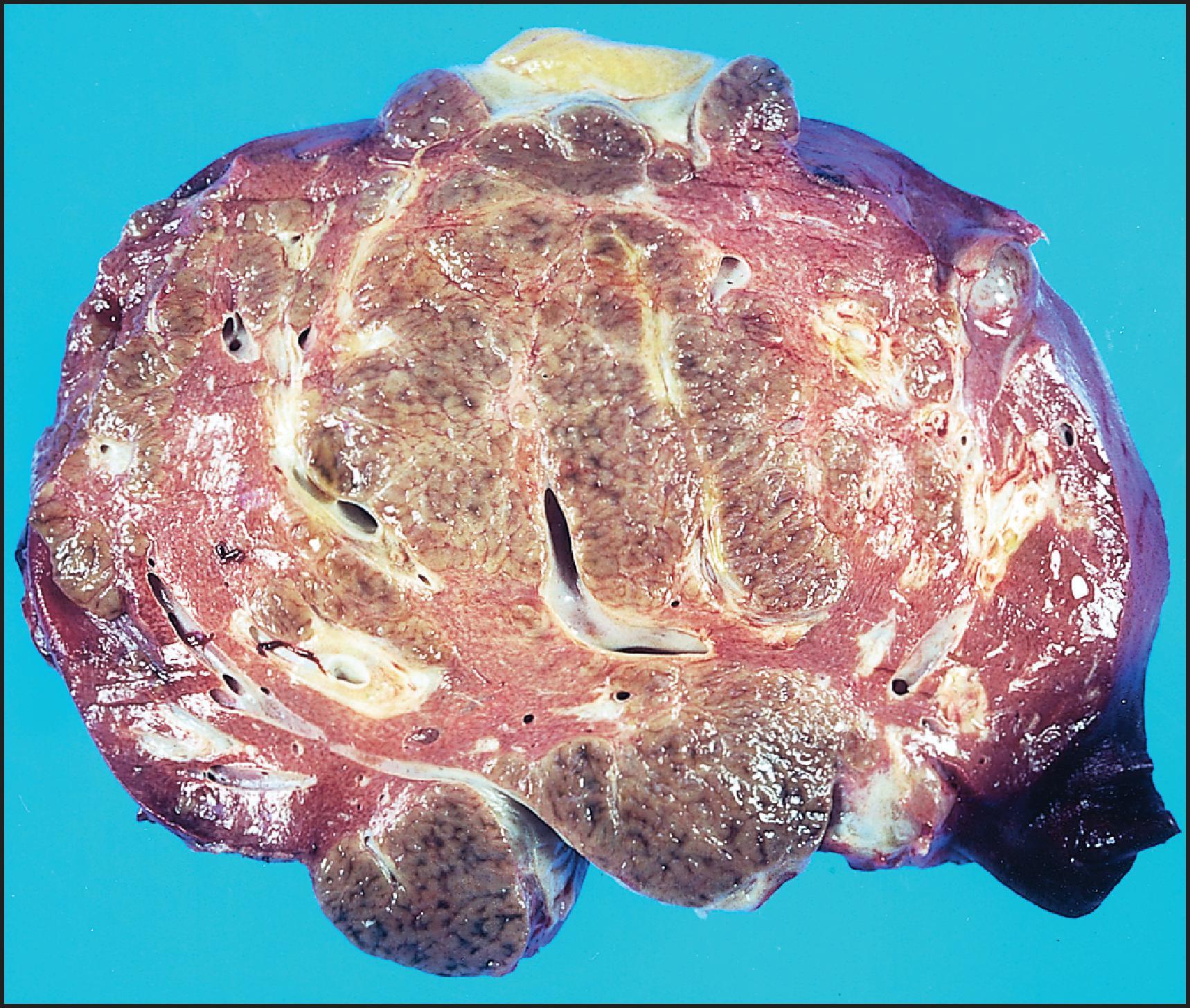
Patients dying of acute liver failure often have damage to other organs, which may significantly contribute to the immediate cause of death. , Findings at autopsy include pneumonia, septicaemia, cerebral oedema, GI haemorrhage and pancreatitis. Such lesions help to explain death when liver cell damage is limited in extent or there has already been substantial regeneration.
The histological classification of acute hepatitis in this chapter is based on different patterns of hepatocellular necrosis. These patterns therefore are briefly reviewed before the microscopic changes of acute hepatitis are described in detail. More than one of the patterns of necrosis described next may be seen in different parts of the same liver and even within a single biopsy specimen.
In the focal form of necrosis, which represents the fundamental lesion of acute viral hepatitis, individual hepatocytes or minute groups of hepatocytes die and are removed. Under the microscope it appears as lymphocytes and macrophages surrounding a damaged or necrotic hepatocyte(s). The mode of death of hepatocytes probably includes both lytic necrosis and apoptosis (see Chapter 1 ), but the relative contribution of each may vary. In the case of apoptosis (or formation of acidophilic bodies), T lymphocytes likely play a role. Apoptotic hepatocytes are also called ‘acidophil bodies’ because of their dark-red staining with eosin. The name ‘Councilman bodies’ is generally used in the setting of yellow fever, as originally described by William Thompson Councilman. The remnants of cells affected by either process are rapidly removed from the site by blood flow or phagocytosis. Clusters of pigment-laden macrophages are also frequently seen throughout the parenchyma in such cases, representing sites of phagocytosis of hepatocellular debris.
The confluent type of necrosis involves groups of adjacent dead hepatocytes or the site where a group of hepatocytes have undergone previous necrosis and removal, so that areas of confluent necrosis are formed. These are often perivenular in location. Confluent necrosis linking vascular structures and portal zones is known as ‘bridging necrosis’. Bridging at the periphery of complex acini links terminal hepatic venules (central veins) to each other but does not involve portal tracts. This is called ‘central-central’ bridging in the lobular nomenclature. The other form of bridging necrosis links terminal hepatic venules to portal tracts (‘central-portal’ bridging). This form is best explained as necrosis of zone 3 of the simple acinus, as described by Rappaport, because this zone touches both terminal hepatic venule and portal tract. Zone 3 bridges are sometimes curved, in keeping with the shape of the zone. When confluent necrosis is more extensive, involving zones 2 and 1 in addition to zone 3, such that entire acini are destroyed, the process is described as ‘panacinar’ or ‘panlobular’ necrosis.
Interface hepatitis, formerly known as ‘piecemeal necrosis’, can be defined as death of hepatocytes at the interface of parenchyma and the connective tissue of the portal zone, accompanied by a variable degree of inflammation and fibrosis. Interface hepatitis was a defining feature of the formerly used category of ‘chronic active hepatitis’, but similar periportal inflammation and hepatocyte death are found in some cases of acute hepatitis.
Features seen in the parenchyma in the classic form of acute hepatitis include liver cell damage and cell death, liver cell regeneration, cholestasis, infiltration with inflammatory cells and prominence of sinusoidal cells ( Fig. 6.2 ). The necrosis may be spotty or confluent. The histological changes, especially confluent necrosis, are often most severe near the terminal hepatic venule. The reason for this zonal distribution has not been established, but possible explanations include metabolic and functional differences among hepatocytes in different zones and the lower oxygen content of the blood in perivenular areas. There is a variable degree of condensation of the reticulin framework, but in the classic form of hepatitis, this does not amount to substantial alteration of structure and vascular relationships. Portal tracts are inflamed, and bile ducts may be damaged.
![Figure 6.2, Classic acute hepatitis. Hepatocyte swelling and lymphocytic infiltrates are seen in the lobule. (Haematoxylin and eosin [H&E] stain.) Figure 6.2, Classic acute hepatitis. Hepatocyte swelling and lymphocytic infiltrates are seen in the lobule. (Haematoxylin and eosin [H&E] stain.)](https://storage.googleapis.com/dl.dentistrykey.com/clinical/HepatitisDuetoHepatotropicViruses/1_3s20B9780702082283000065.jpg)
Little is known about the earliest changes of acute viral hepatitis in humans. Available information suggests that Kupffer cells are prominent and may show mitotic activity and that hepatocellular necrosis occurs early in the disease course. In the setting of acquired hepatitis after LT, hepatocyte necrosis is seen as an early indicator of hepatitis.
Hepatocyte swelling is a common feature in acute hepatitis and results mainly from dilation of the endoplasmic reticulum. The swollen cells are pale staining as a result of intracellular oedema ( Fig. 6.3 ). Because of their combined swelling and rounding, these cells appear similar to the ‘ballooning degeneration’ seen in alcoholic and nonalcoholic fatty liver disease (NAFLD), but they should not be mistaken as indicative of such concomitant injuries. The nuclei of the affected cells are also swollen, because of the accumulation of proteins. Nucleoli of hepatocytes may be more prominent than usual, mitotic figures are occasionally seen, and multinucleation may be increased.
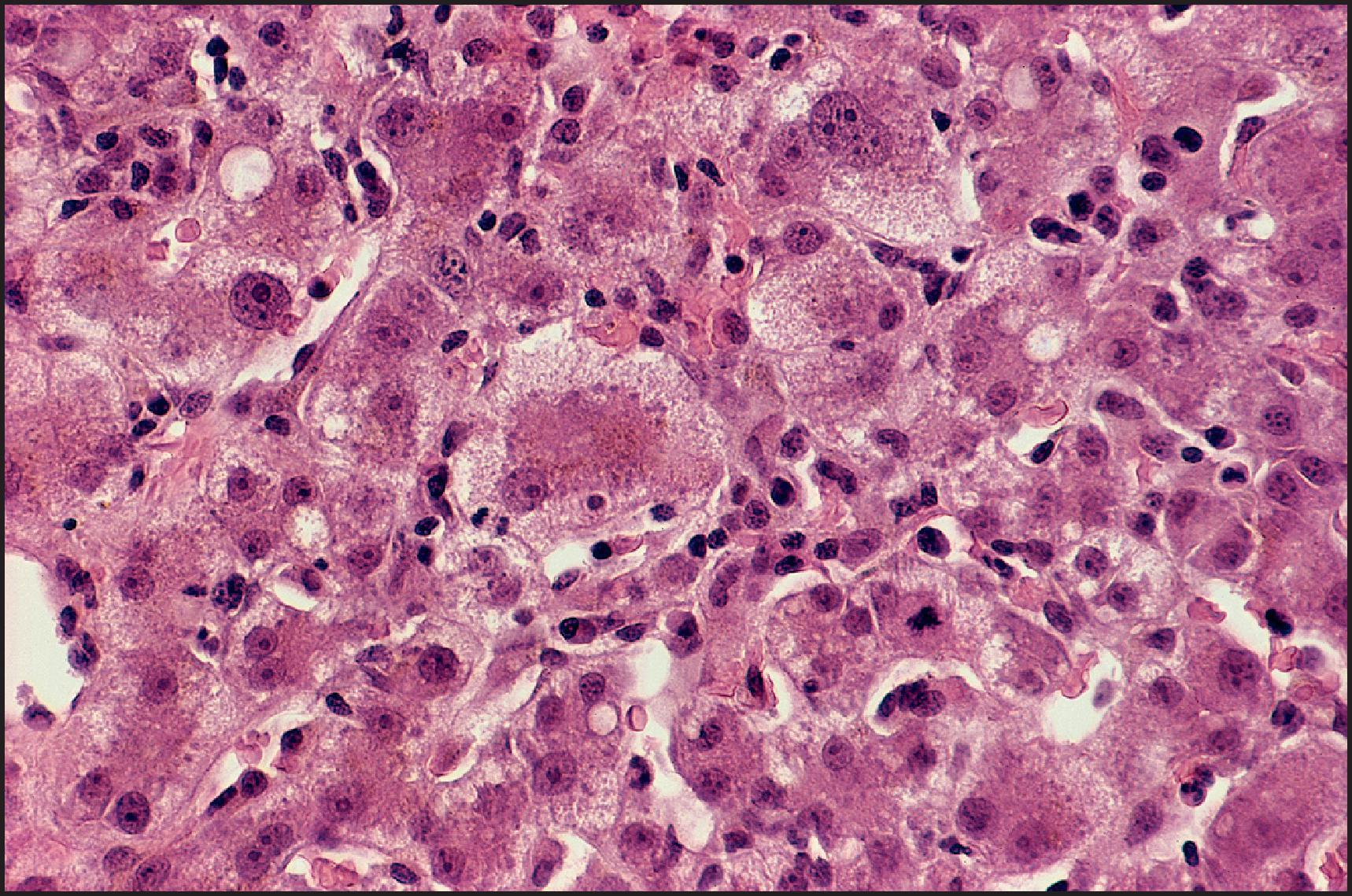
In addition to swollen cells, there are hepatocytes undergoing apoptosis with deeply acidophilic cytoplasm, in which the nucleus may be seen undergoing pyknosis. Such acidophilic hepatocytes are small compared with ballooned cells but may occasionally be larger than normal hepatocytes. Acidophilic cells have round or irregular outlines, sometimes assuming rhomboid, angular shapes, apparently determined by the pressure from adjacent swollen hepatocytes. Acidophil bodies—rounded, apoptotic cell remnants extruded from the hepatocyte plates and now located in the sinusoids ( Fig. 6.4 )—are probably a later stage of this process. These may or may not contain pyknotic nuclear remnants and may appear thick and refractile. Affected cells eventually undergo fragmentation and phagocytosis by macrophages. Some acidophil bodies are in close contact with lymphocytes or Kupffer cells, whereas others appear to lie free within liver cell plates or sinusoids, with no other cells in proximity. As with ballooned hepatocytes, acidophil bodies are not specific for acute viral hepatitis, although they often constitute a striking histological feature of the disease.
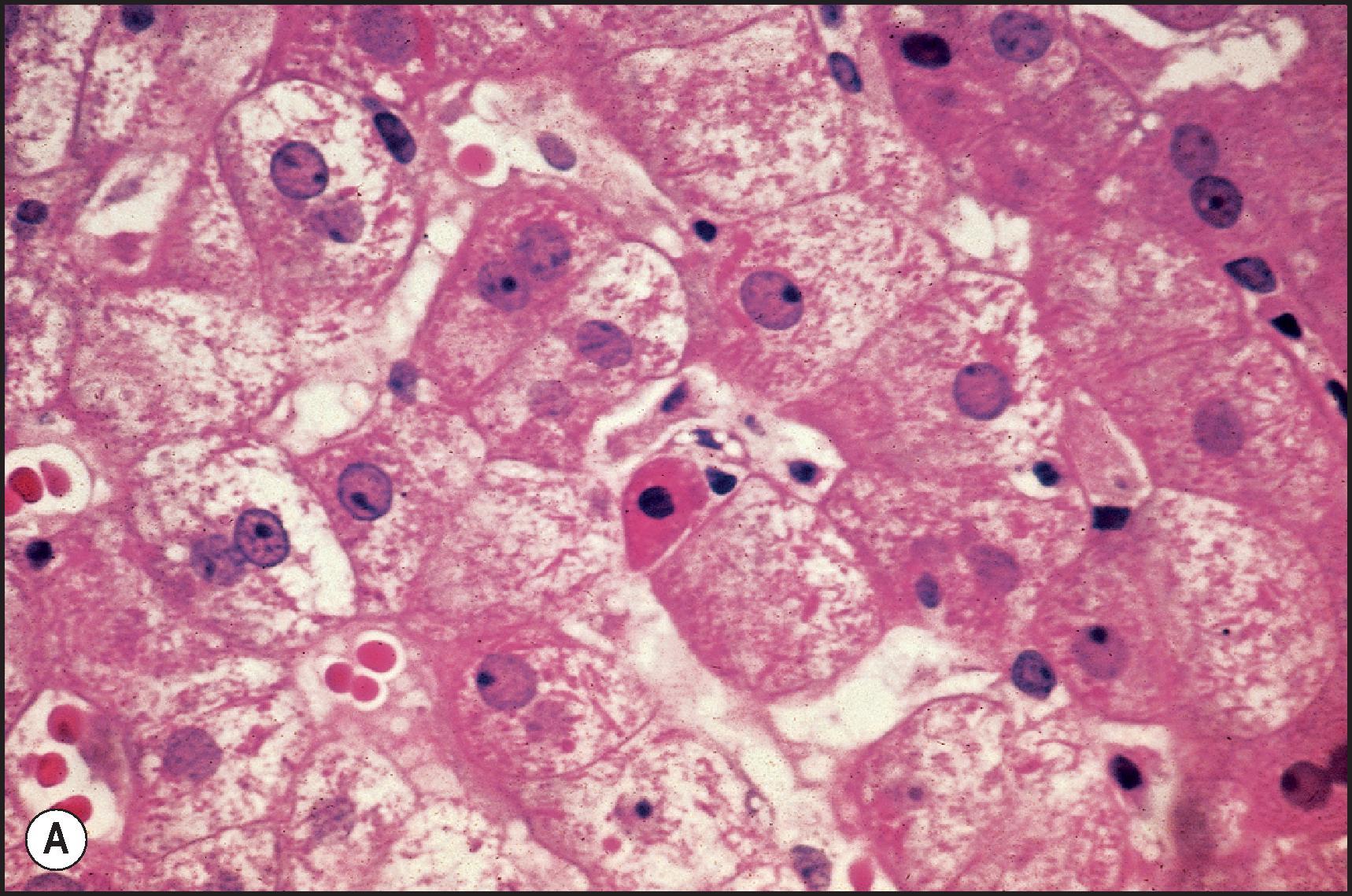
Loss of individual hepatocytes leads to localized defects in the liver cell plates, with consequent distortion and condensation of the supporting reticulin framework, especially when the cell death is confluent. Although an overall increase in connective tissue is probably slight in acute hepatitis and therefore difficult to detect by light microscopy (with conventional staining methods), immunocytochemical and ultrastructural evidence indicates synthesis of collagen fibres and associated proteins such as fibronectin, as well as increased prominence of stellate cells. There may also be degradation of these components, so that presumably a dynamic balance determines the degree of fibrosis in an individual case. The distortion of cell plates is accentuated by regeneration of hepatocytes. This is recognized by the appearance of mitotic figures, rare in normal liver, and by a change in the structure of the cell plates; these become more than one cell thick or assume the structure of short cylinders known as liver cell ‘rosettes’. The end result of focal necrosis, reticulin condensation and regeneration is a diagnostically helpful disarray of the liver cell plates (see Fig. 6.3 ).
Cholestasis is common in acute hepatitis. It varies from the presence of scanty, small bile plugs in perivenular canaliculi to extensive bile plug formation with canalicular dilation. Intracellular bile is more difficult to recognize because bile is easily confused with lipofuscin pigment. For this reason, cholestasis should only rarely be diagnosed on the basis of routine stains in the absence of canalicular bile plugs. Morphological cholestasis may be accompanied by clinical and biochemical features of cholestasis, but this is variable.
The inflammatory infiltrate of acute viral hepatitis is mainly composed of lymphocytes, plasma cells and macrophages in varying proportions (see Figs 6.2 and 6.4 ). Within the parenchyma, the infiltrate is most abundant where liver cell damage is greatest, usually in the perivenular zones. Lymphocytes are often attached to endothelial cells of the central and portal venules. Mononuclear phagocytes, either activated Kupffer cells or circulating phagocytes, are seen as large, irregular cells in areas of liver cell dropout ( Fig. 6.5 ). They often show brown pigmentation from phagocytosis of bile or accumulation of lipochrome pigment. Iron is also abundant in some cases. The iron-containing phagocytes are sometimes found in the form of small clumps composed of several cells. Whatever the pigment, the periodic acid-Schiff (PAS) reaction after diastase digestion is usually strongly positive ( Fig. 6.5 ).
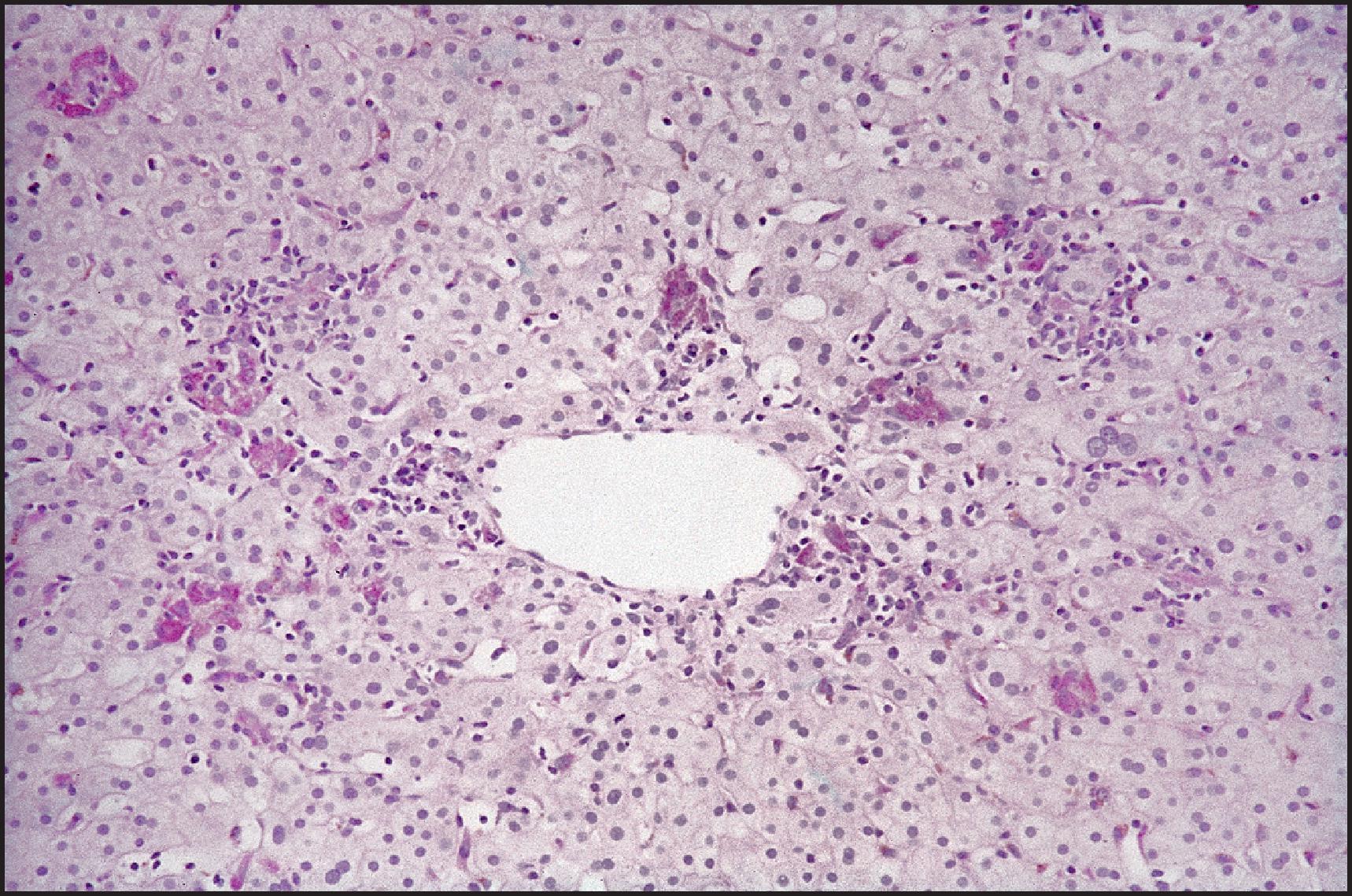
Most portal tracts in acute viral hepatitis are infiltrated with inflammatory cells to a greater or lesser extent, and in the classic form, lymphoid cells predominate. Cytotoxic T cells (CD45RO+) typically are more prominent than B cells (CD20+). Plasma cells are common, the majority containing immunoglobulin G (IgG). Perls-positive, iron-rich macrophages may be present. Portal infiltration may be diffuse or focal. Mild bile duct damage is common and is seen as minor irregularities of shape, size and arrangement of the epithelial nuclei of the small, interlobular ducts. Less frequently, the ductal epithelium becomes vacuolated and disrupted; such lesions are seen most often near or within lymphoid follicles, but granulomas are not associated with the duct lesion as in primary biliary cholangitis (PBC). Irregular dilation of ductules is not typical but has been described in hepatitis A. In general, however, a finding of dilated, bile-containing ductules or canals of Hering, referred to as ‘ductular cholestasis’ or ‘cholangitis lenta’, should arouse a suspicion of sepsis, a complication of severe acute hepatitis in some patients. Bile duct damage in acute hepatitis does not usually correlate with a prolonged cholestatic clinical course, probably because there is not the widespread and progressive destruction of the duct system found in disorders such as PBC.
The outlines of the portal tracts may remain intact and sharply delineated in classic acute hepatitis with spotty necrosis. More often, infiltration by lymphoid cells and accompanying disruption of the limiting plate of hepatocytes lead to an irregular outline (or interface hepatitis). Severe periportal necrosis and inflammation in acute hepatitis is discussed later.
All the previous features of classic acute hepatitis with spotty (focal) necrosis vary in extent. Therefore, the appearance ranges from a mild hepatitis with minimal cell damage or inflammatory cell infiltration to widespread changes throughout the parenchyma. In the latter case the diagnosis is largely straightforward, but in the former the distinction from nonspecific reactive changes or nonhepatitic cholestasis may be difficult or even impossible. These characteristics of classic acute hepatitis with spotty (focal) necrosis also form the basis of the other three forms of acute hepatitis, which may be regarded as exaggerations of one or another component of the classic form.
Multinucleation may be prominent with the formation of giant hepatocytes ( Fig. 6.6 ). When this change is widespread, the appearances resemble those of neonatal giant cell hepatitis. Post infantile giant cell hepatitis is a rare, nonspecific subtype of hepatitis, which can be seen in a wide variety of inflammatory and cholestatic liver diseases. Autoimmune hepatitis should be considered in the differential diagnosis.
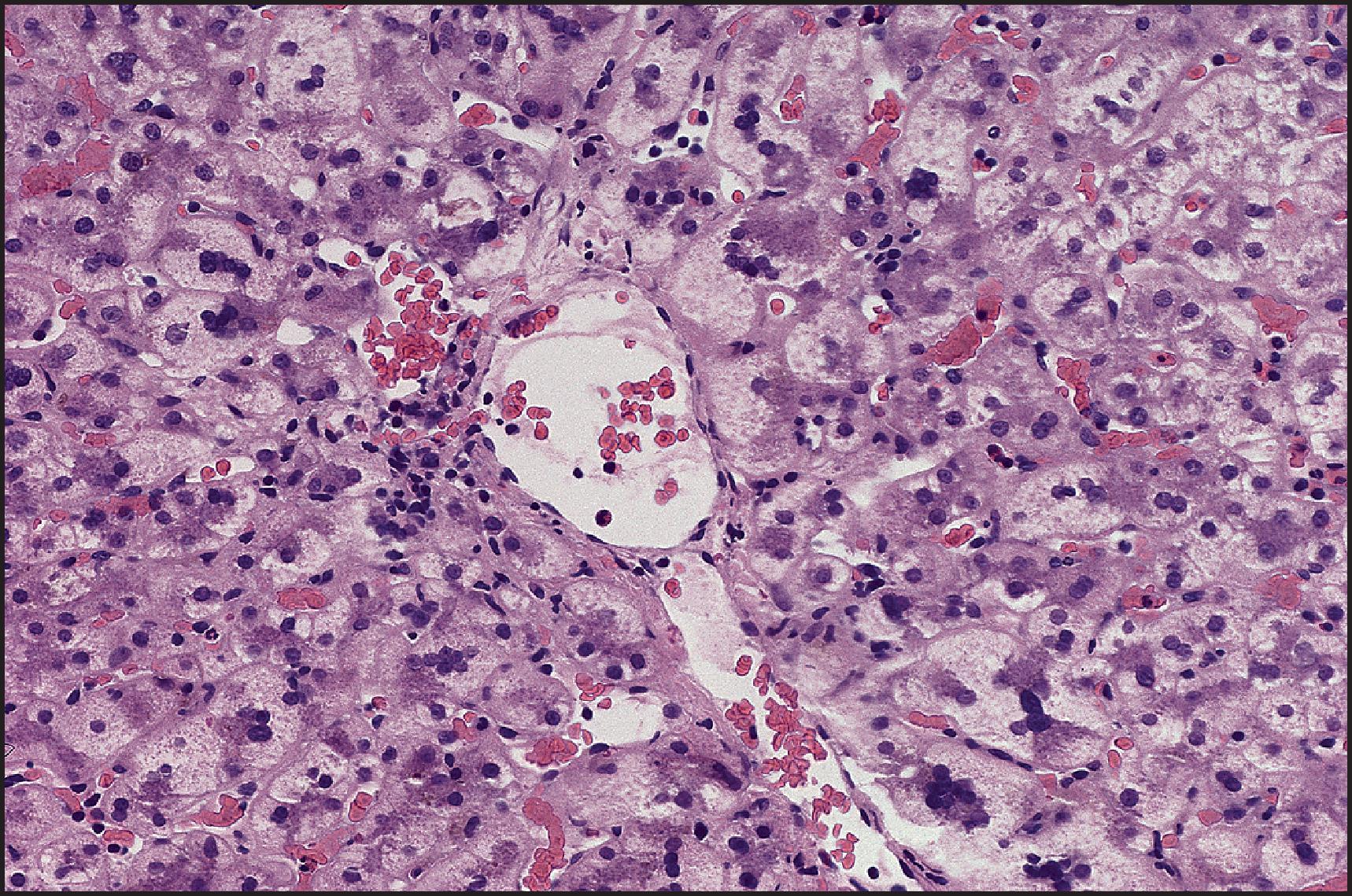
Cholestatic variants have been described, especially in association with hepatitis A and E. In these cases, the degree of necrosis may be minimal and the cholestasis quite prominent, mimicking biliary obstruction.
In the confluent form of acute hepatitis, the features described for classic acute hepatitis with spotty (focal) necrosis are seen, but in addition, bridging in the form of confluent necrosis linking central venules to portal tracts (central-portal bridging) or linking central venules to each other (central-central bridging) may also be present.
Of these two forms of confluent necrosis, central-portal bridging may be more significant for the progression of the lesion than the central-central necrosis. For example, in patients who develop chronic liver disease, central-portal confluent necrosis may hasten the onset of cirrhosis by creating early disruption of the normal architectural relationships on conversion of the bridges into fibrous septa, which undergo contraction. In patients who do not develop chronic hepatitis, bridging necrosis of central-to-portal type may lead to a certain degree of scarring and distortion, sometimes seen in biopsy specimens taken many months after the acute attack. However, the prognostic significance of central-portal bridging necrosis remains controversial. Boyer and Klatskin believed that patients with this type of bridging necrosis were more likely to develop chronic hepatitis, a conclusion later supported by another study. However, both these groups included not only central-portal bridging as previously described but also bridges linking portal tracts, probably representing periportal necrosis. Others do not consider bridging as a good predictor of chronicity. , Nevertheless, bridging must be regarded as an important histological feature seen in the more severe forms of acute hepatitis.
The appearance of the necrosis varies according to the stage of the illness. In the early stages of bridge formation, substantial numbers of hepatocytes die. This is followed by disappearance of the affected cells, leaving a loose connective tissue stroma infiltrated with lymphocytes and macrophages ( Fig. 6.7 ). With time, the stroma collapses to form more or less dense ‘passive’ septa, which intersect the liver tissue. Confluent/bridging necrosis can develop in the early weeks of acute hepatitis, but its absence on a biopsy sample does not exclude the possibility that it will develop later.
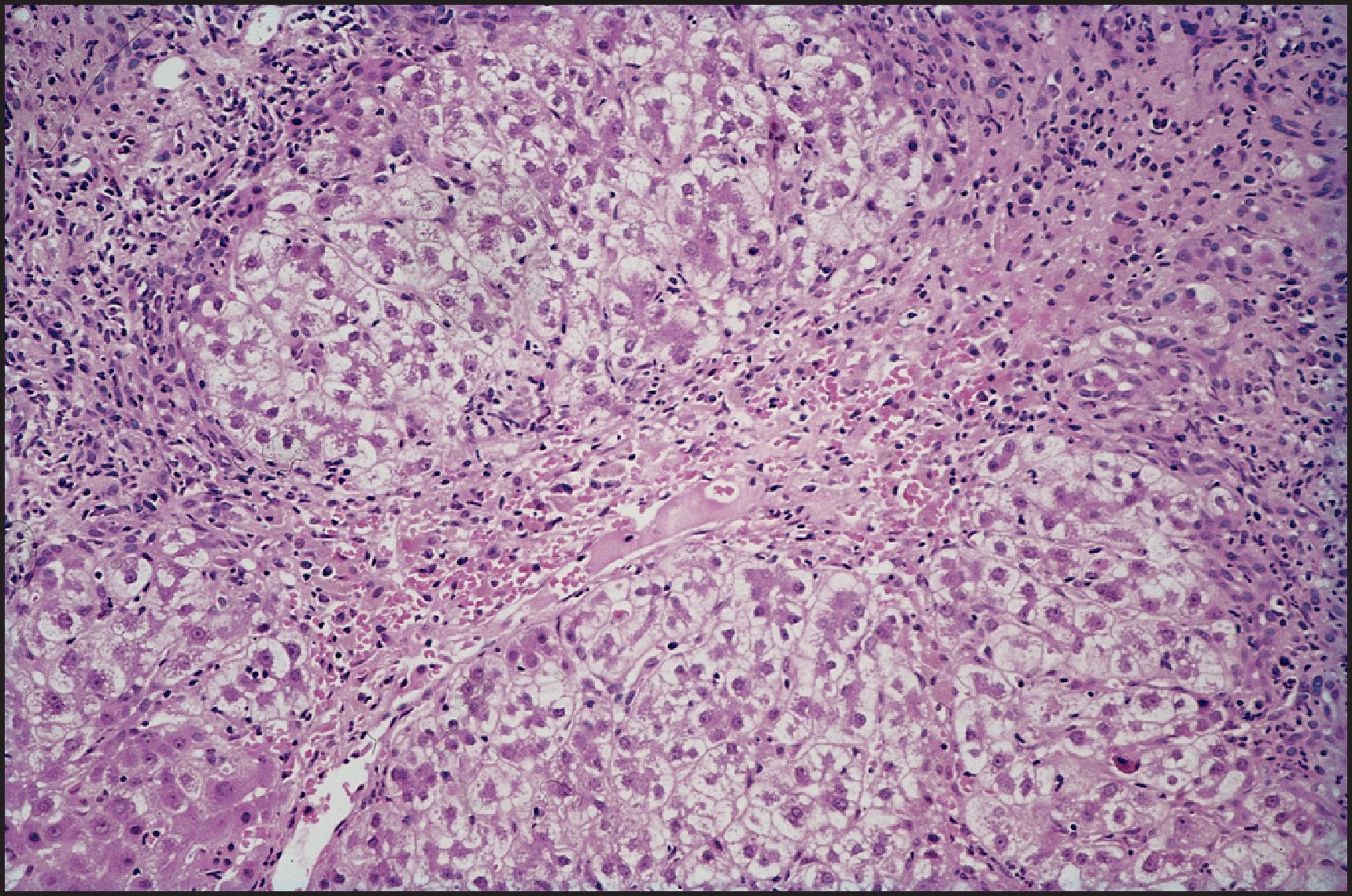
The combination of necrosis, collapse and hepatocellular regeneration leads to architectural distortion, which in turn can easily be mistaken for that of chronic hepatitis or cirrhosis when examining only haematoxylin and eosin (H&E)-stained slides. Helpful differentiating features include the presence of other lesions of acute viral hepatitis and the staining properties of the septa. In addition, the stroma in zones of recent necrosis will tend to show the residual structure of the cell plates on reticulin stain ( Fig. 6.8 ); this is not readily seen in chronic hepatitis or cirrhosis. The stroma is often more haemorrhagic or contains more macrophages than in typical chronic hepatitis. Trichrome stains may also show a two-tone appearance, with darker staining of established areas of scar due to thicker collagen bundles (comparable to the normal residual portal tract collagen), compared to lighter staining of areas of recent collapse, where the residual framework and lack of hepatocytes account for the staining ( Fig. 6.9 ). Also, recently formed passive septa are virtually devoid of elastic fibres ( Fig. 6.10 ), whereas the older septa of chronic hepatitis and cirrhosis contain increasing numbers of these fibres. , Extensive liver cell destruction in acute hepatitis with confluent necrosis will also display significant ductular reaction at the interface of portal tracts and parenchyma, aspects of which are also often contained within the areas of bridging necrosis themselves; these are absent in the fibrous septa of chronic hepatitis.
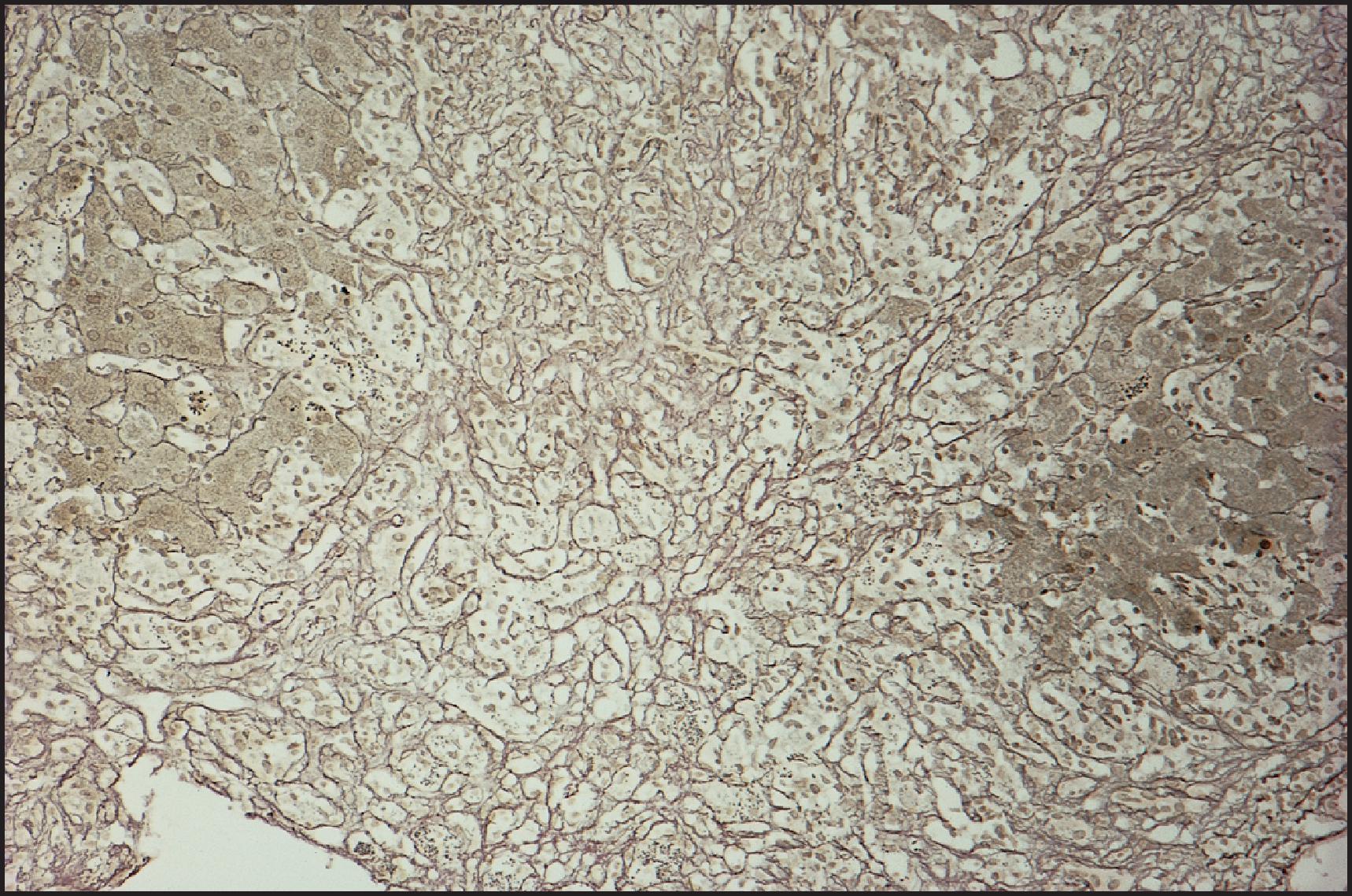
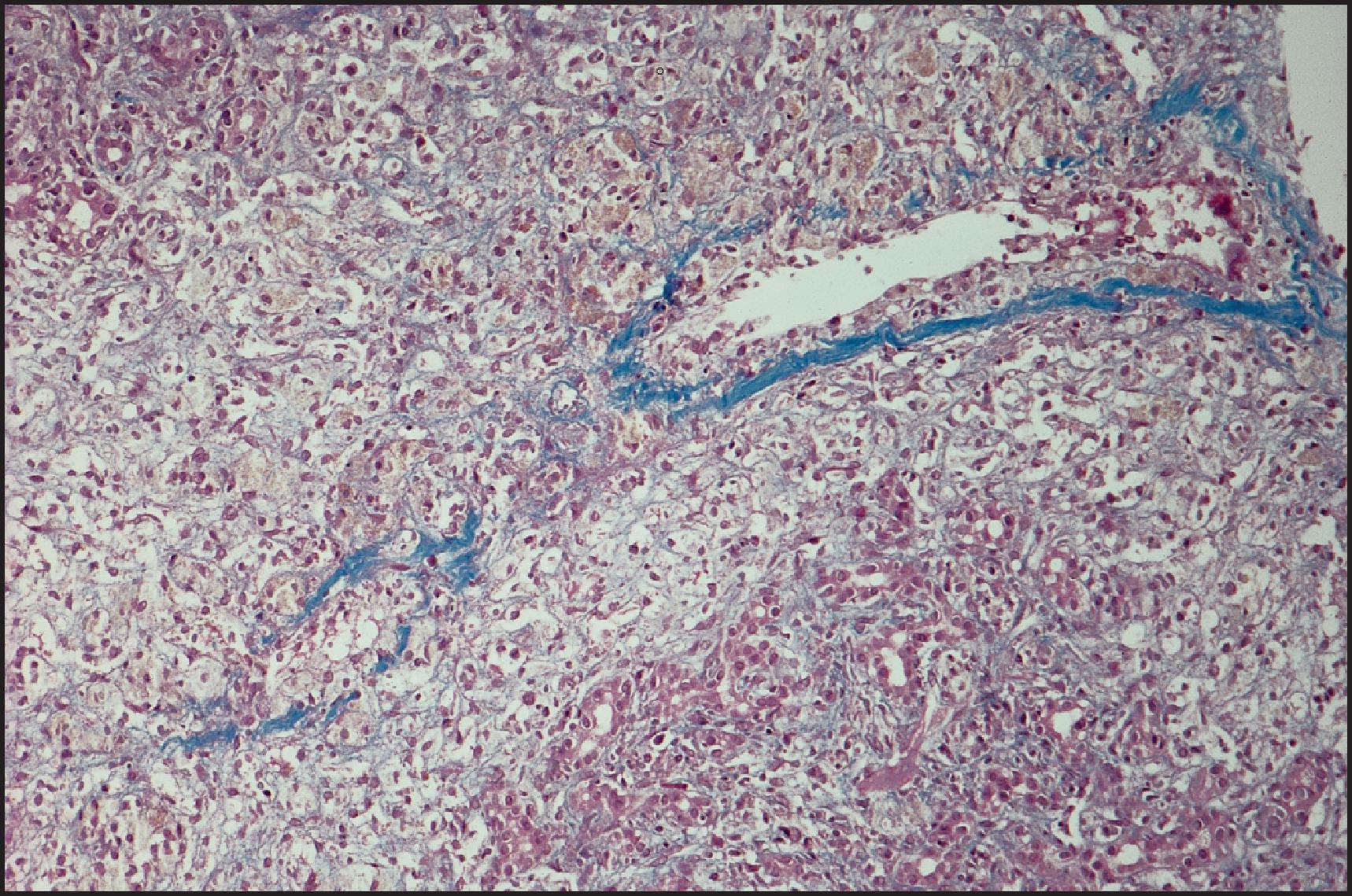
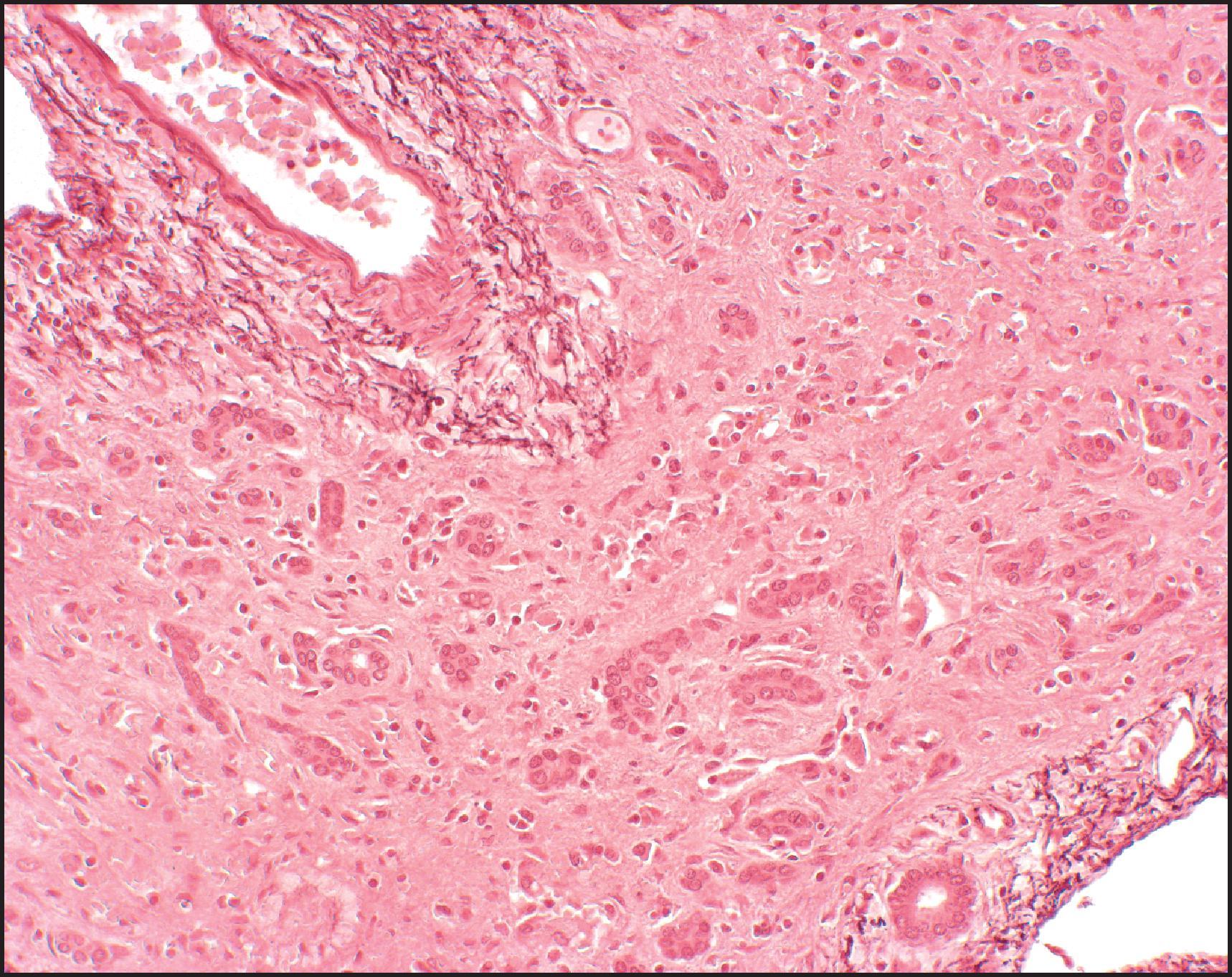
The panlobular form of acute hepatitis represents the most severe degree of necrosis, with complete or near-complete destruction of hepatocytes in entire lobules. When several adjacent lobules undergo necrosis, the term ‘multilobular’ or ‘multiacinar’ is applicable. The term ‘massive hepatic necrosis’ has been used when the liver shows extensive, diffuse panlobular (panacinar) and multilobular necrosis >60–70%, as noted on examination of the entire liver on explant, autopsy or clinical visualization. This lesion is typically the morphological counterpart of the clinical condition of acute liver failure (see Box 6.1 ), or fulminant liver failure, which is often fatal. The term ‘submassive necrosis’ has also been sometimes used for lesions that involve global necrosis of 30–70% of the entire liver.
Percentage of necrosis has been proven to have significant discriminatory prognostic value. , In the study by Katoonizadeh and colleagues, a positive correlation between percentage of hepatocyte loss (>50%) and clinical parameters of liver impairment such as model for end-stage liver diseases (MELDs) was observed. Accordingly, Singhal and colleagues demonstrated a correlation between extent of necrosis and prognosis. In their study, based on transjugular liver biopsy, none of the patients with >75% of necrosis survived without liver transplant, while all 10 patients with hepatocellular necrosis <25% and 8 (61.5%) patients with necrosis 25–50% recovered with conservative treatment. Therefore, liver biopsy can provide important additional information in a patient with severe acute liver impairment.
However, for reasons as yet unknown, panlobular necrosis may spare large areas of the liver (see Fig. 6.1 ). Thus determination of the degree of total loss of liver parenchyma based on needle biopsy might be affected by the topographical variability of the necrosis that can occur in acute viral hepatitis.
Panlobular necrosis on a smaller scale is not necessarily accompanied by severe disease clinically and may be seen particularly in a subcapsular location (or rarely at other sites), adjacent to less severely damaged liver tissue. It is even likely that panlobular necrosis can occur in the entire absence of severe symptoms, because areas of past necrosis and collapse may be found incidentally in the liver of patients with no history of acute hepatitis. Conversely, some patients have severe clinical hepatitis in the absence of panlobular necrosis, and it must then be assumed that a large proportion of hepatocytes have sustained sublethal damage.
The macroscopic appearance in this form of acute hepatitis is described earlier. Microscopically, acute hepatitis with panlobular necrosis is characterized by extensive liver cell loss, the presence of ductular-like structures around portal tracts, inflammatory cell infiltration and collapse ( Figs 6.11 and 6.12 ). The degree of collapse may be judged by the extent of approximation of adjacent portal tracts, which increases over time, and by the density of the collapsed reticulin framework. As in confluent/bridging necrosis, areas of recent collapse contain few if any elastic fibres, whereas staining for these fibres becomes positive later. Haemorrhage in the collapsing zone may be prominent in some cases (see Fig. 6.11 ). Inflammatory cell infiltration is mixed and variable in degree. The main infiltrating cells are often macrophages (see Fig. 6.12 ), which usually contain lipochrome pigment and should not be mistaken for residual hepatocytes. Mononuclear infiltrates in areas of surviving parenchyma are sometimes surprisingly mild compared with classic acute hepatitis. Ductular reactions contain cells with morphology ranging from hepatocytic to cholangiocytic, with many intermediate forms; some suggest that these features represent hepatobiliary stem cell response, although biliary metaplasia of injured hepatocytes may also play a role. , Venulitis of central veins can be seen ( Fig. 6.13 ). Evidence of significant parenchymal cell regeneration is present even in fatal cases. The common hepatotropic viruses can cause panlobular necrosis, but the mechanisms responsible for the development of massive necrosis, instead of the more typical pattern of spotty necrosis, are unknown. Possibilities include overwhelming viral infection, superinfection with a second virus and microcirculatory failure. In some cases, mutants of HBV have been implicated. ,
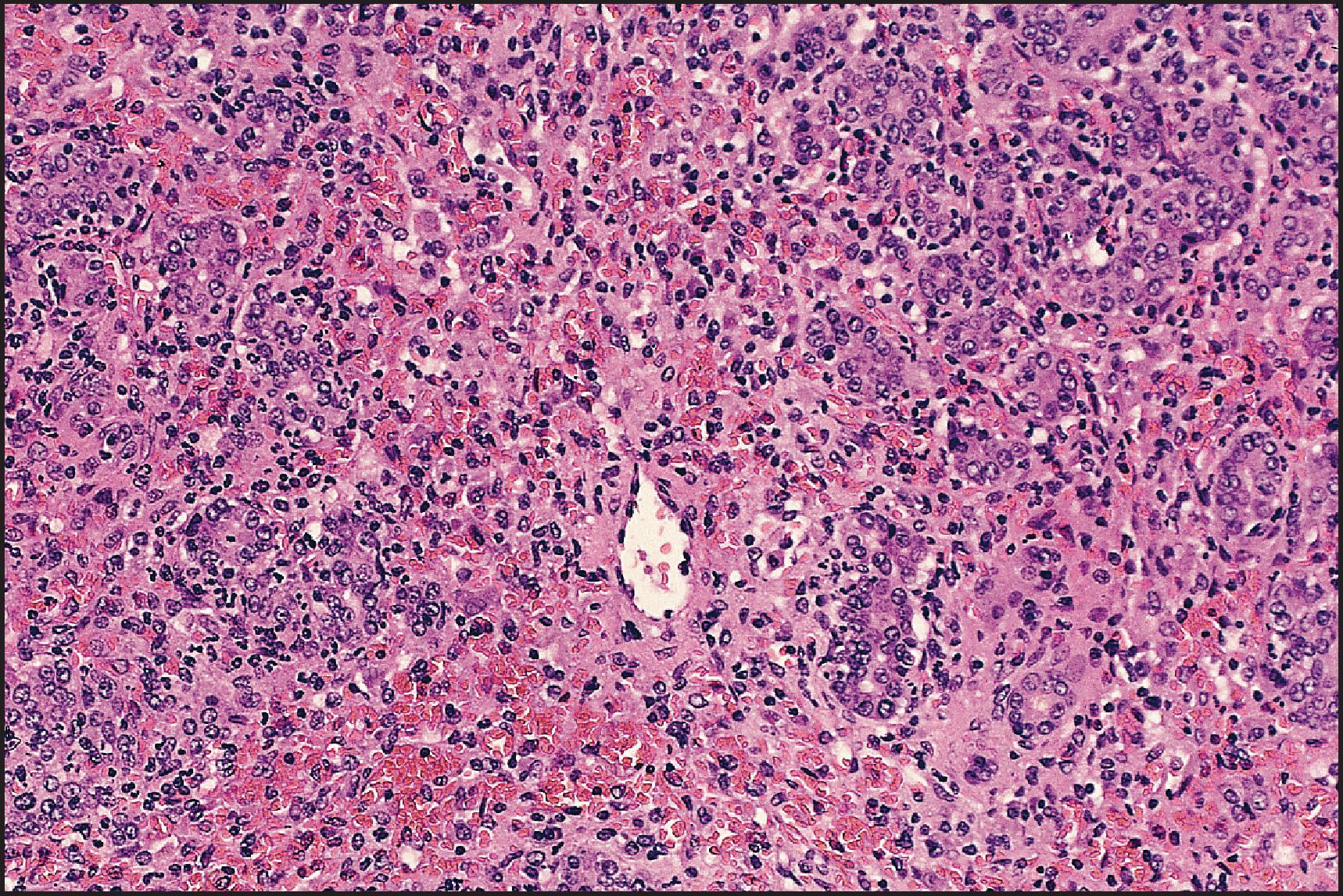
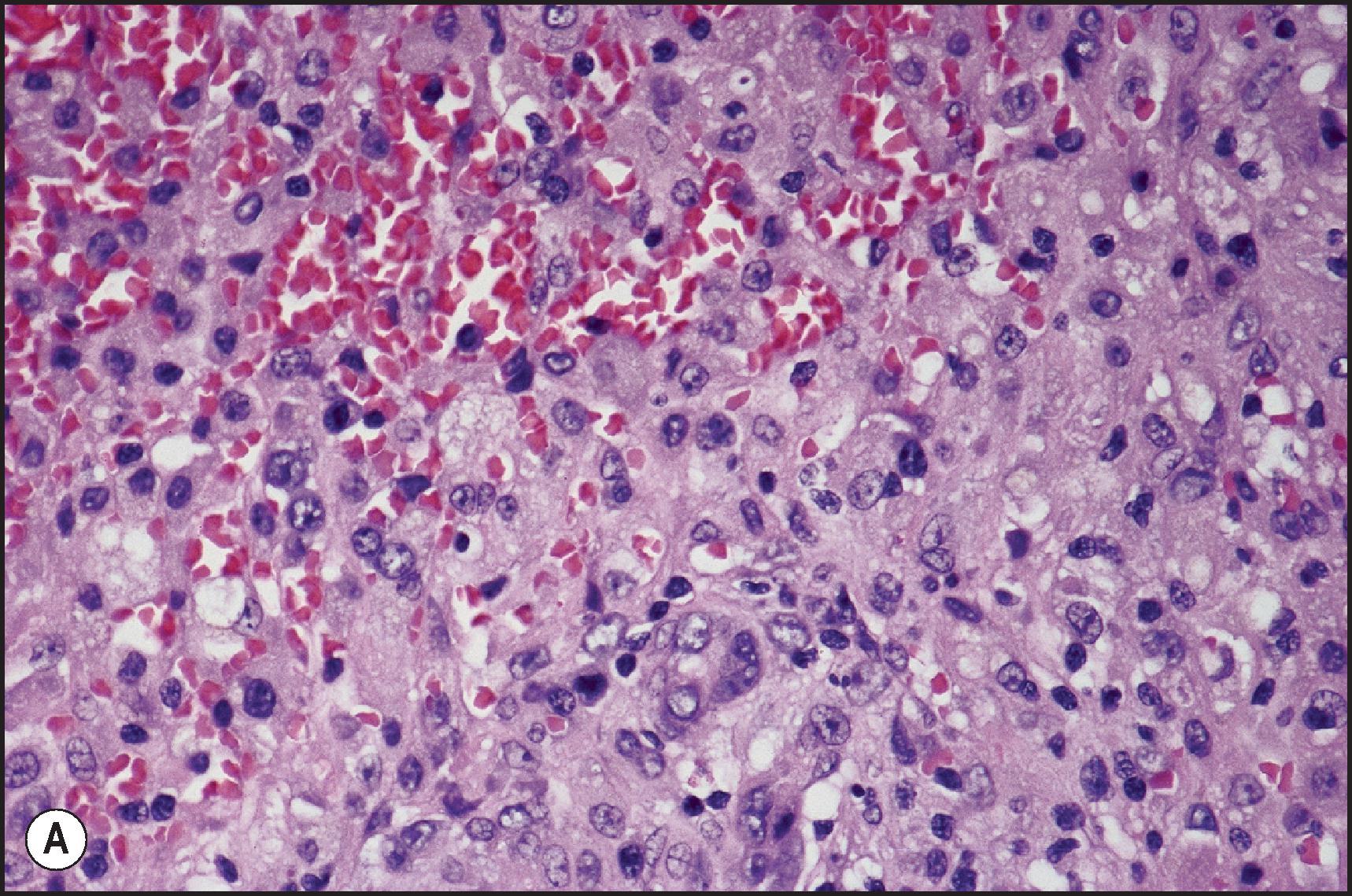
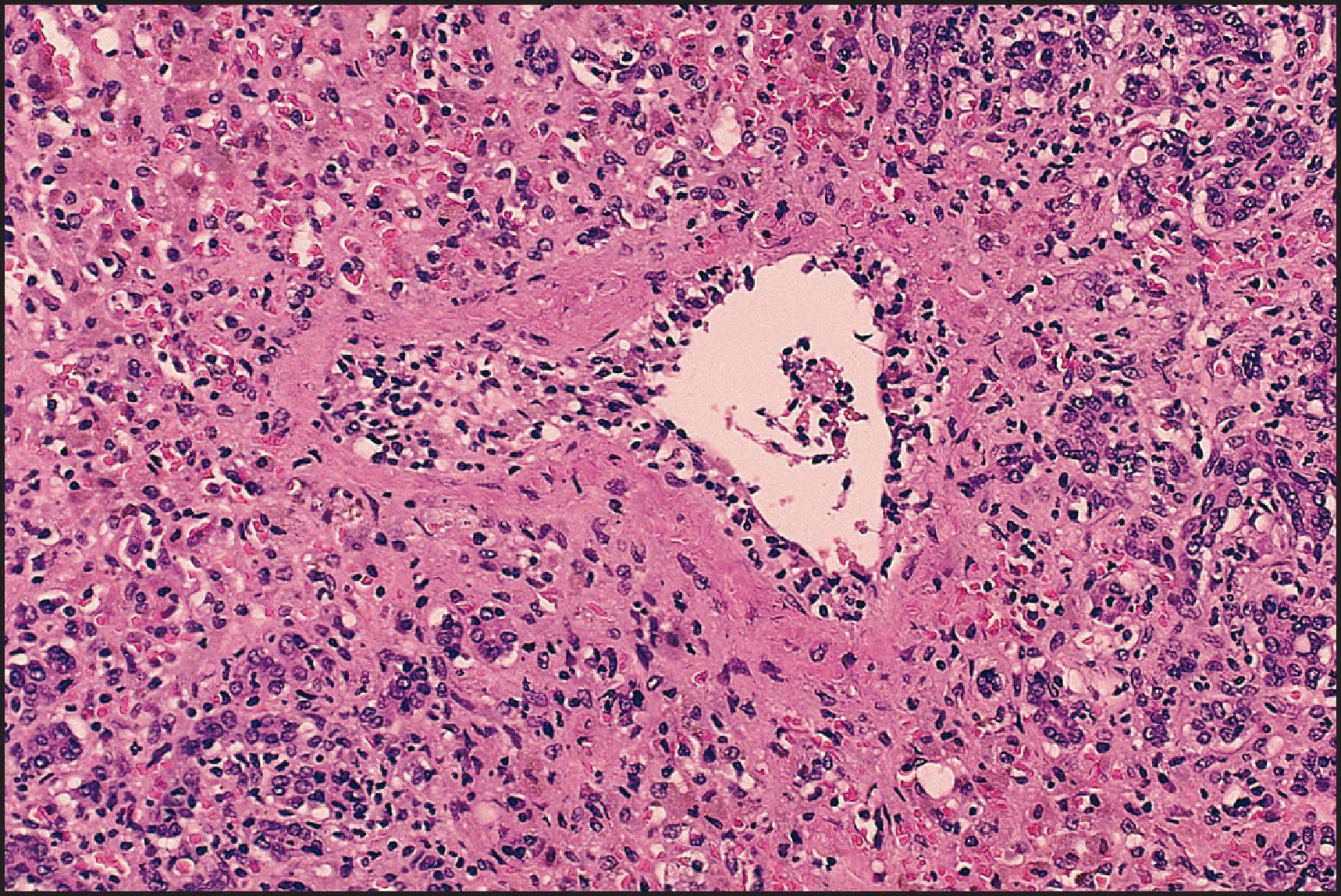
In this pattern the usual changes of classic acute hepatitis are seen to a greater or lesser extent, but there is also a substantial degree of necrosis in the periportal zones, accompanied by significant periportal inflammatory infiltration ( Fig. 6.14 ). Lymphocytes and plasma cells usually predominate in the portal and periportal infiltrate. Ductular reaction may be present. One effect of the periportal necrosis is apparent widening of the portal tracts and linking of tracts, as seen in two-dimensional sections. Changes in other parts of the parenchyma may be mild or severe. In some patients with hepatitis A, for example, the portal and periportal changes may be accompanied by minimal perivenular necrosis. In contrast, with other patients, the biopsy may show a combination of periportal necrosis and central-portal bridging.
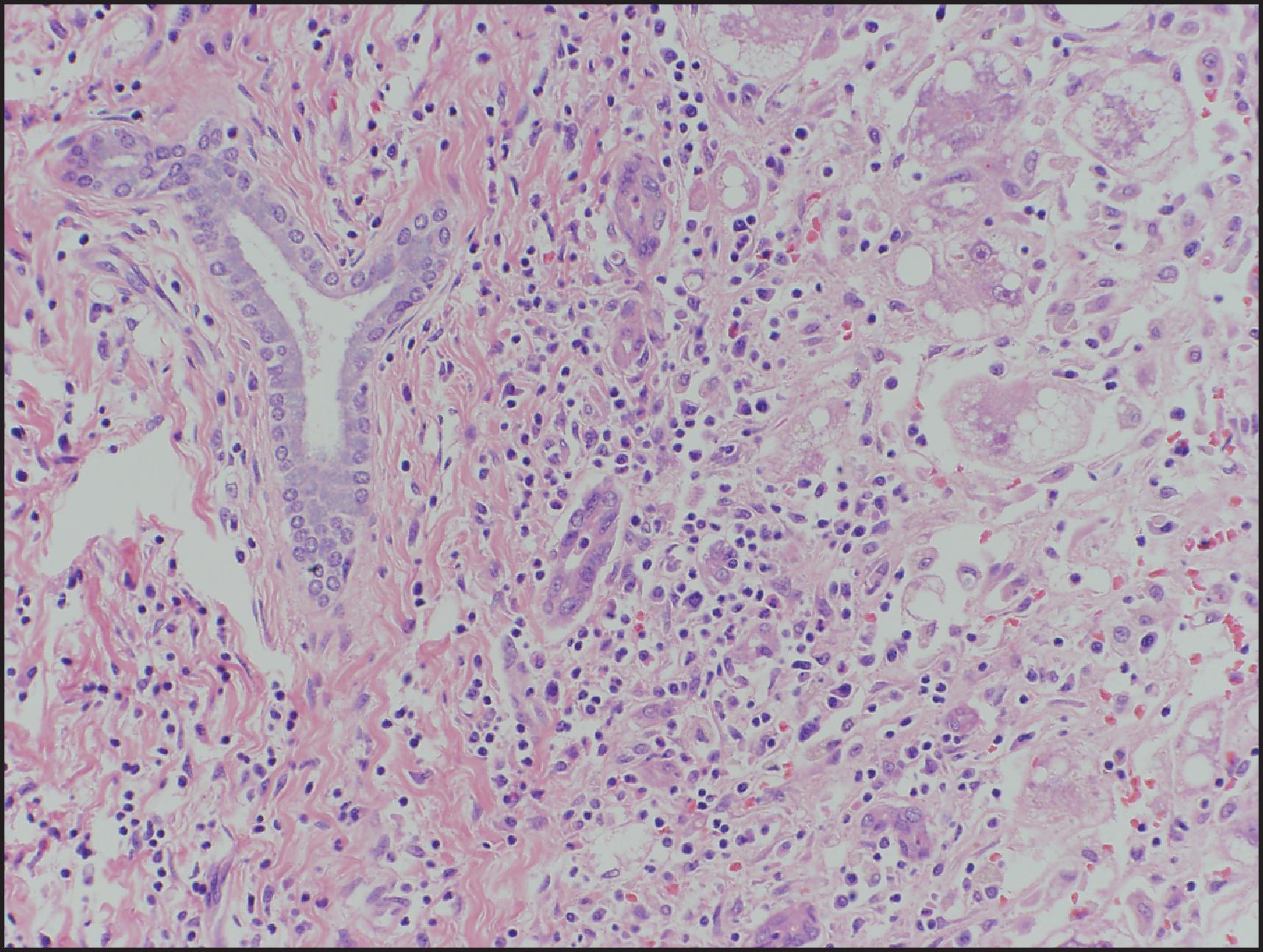
Unlike the periportal necrosis (interface hepatitis) of chronic hepatitis, trapped periportal hepatocytes are usually absent or scant in number in the necrotic zone of acute hepatitis. Nevertheless, a close resemblance is seen between these two types of necrosis. Patients with acute hepatitis may thus be incorrectly diagnosed with chronic hepatitis on biopsy. This error can usually be avoided if the patient's history is unequivocal and available to the pathologist and if an examination is performed for the typical parenchymal changes of acute hepatitis.
As previously noted, little is known about the early stages of acute hepatitis. The descriptions given in this chapter refer to the fully developed acute lesion, but the time over which this lesion develops varies widely from patient to patient. In some, the lesion begins to regress after a few weeks, whereas in others the course is over many months. There is international agreement that the term ‘chronic hepatitis’ should be used for inflammation of the liver continuing without improvement for more than 6 months. However, there is overlap between acute and chronic disease; acute hepatitis may last for more than 6 months in some patients, regressing slowly thereafter, whereas chronic hepatitis may become established in the first few weeks or months.
Following the fully developed stage of acute hepatitis, there is a stage of regressing and finally residual hepatitis. During regression, necrosis diminishes or ceases, and phagocytic activity predominates. Portal inflammation is still seen, and in severe hepatitis, there may be ductular reaction. In patients with marked cholestasis, bile stasis can persist after much of the inflammatory activity and necrosis has subsided, often in association with a cholestatic clinical course. Condensation of the reticulin framework marks zones of liver cell loss, and necrotic bridges undergo collapse to form passive septa. The risk of confusion with chronic liver disease and/or cirrhosis thus increases. In this regressing stage, however, the lesion can still be recognized as acute hepatitis on the basis of hepatocellular changes, parenchymal inflammation and phagocytic activity. In severe forms of acute hepatitis with collapsing stroma, the absence of established scarring, as evidenced by lack of dense bundles of collagen and elastic fibres, can help distinguish acute from chronic disease.
The stage of regression passes imperceptibly into a residual stage, which is much less characteristic and easily mistaken for a nonspecific reaction unrelated to viral hepatitis. Changes include slight alterations of architecture, minor degrees of septum formation, focal liver cell regeneration (as shown by variation in liver cell size and appearance from one area to another), inflammatory infiltration and Kupffer cell activation. Clumps of Kupffer cells containing iron or lipochrome pigment are often present. Cholestasis, if still present, is mild. Gradually, these residual changes fade, and the liver returns to normal. Minor degrees of inflammation and phagocytic activity may be seen up to 1 year or more after onset.
Acute hepatitis due to hepatotropic viruses is only one cause of an acute hepatitis syndrome, and the typical clinical question on presentation is the aetiology of new-onset hepatic injury. This challenge is generally a clinical question rather than a pathological differential, because diagnostic liver biopsy is usually not pursued in the acute setting and the virological tests allow the diagnosis of viral infection in virtually all cases. Indeed, the aetiology of acute viral hepatitis is appropriately evaluated by assessing the presence of antibody to the respective viral types. Acute HAV infection is indicated by the presence of IgM anti-HAV antibody. Acute HBV infection is identified by the presence of hepatitis B surface antigen (HBsAg) with coexisting IgM anti-hepatitis B core antibody (IgM anti-HBc). Acute HCV infection is defined earliest by the presence of HCV RNA, although current assays for hepatitis C antibody (anti-HCV) are sensitive and able to detect anti-HCV after several weeks of infection. Acute infection with hepatitis D virus (HDV) is defined by the presence of HDV RNA in serum and antibody testing showing anti-HDV IgM. Although antibody may be both IgG and IgM, the IgM response usually predominates in acute infection. Anti-HDV IgM levels fall if acute infection resolves. HDV always exists in the context of hepatitis B co-infection because HDV requires the metabolic capability of HBV to survive. HEV infection can be detected by the presence of an antibody to the virus (IgM anti-HEV) and detection of HEV RNA. Anti-HEV IgM antibody positivity can be considered an important marker for acute HEV infection. Anti-HEV IgM antibodies positivity lasts for a short period of time (approximately 3–4 months), but sometimes it persists for a year. The pretest probability of HEV infection impacts the interpretation of test results, and a significant proportion of ‘positive’ tests for anti-HEV done in areas of low prevalence may be false-positive.
If a biopsy is done, the lesions are sufficiently diffuse within the liver to make a diagnosis of acute hepatitis with confidence even on small specimens. This may not hold true for some examples of panlobular necrosis, but this exception rarely presents real diagnostic problems when clinical data are taken into account. It should be noted, however, that it is difficult to distinguish a cause for acute hepatitis by morphological means alone, so clinical information and correlation are imperative.
From a histological perspective, three main groups of disease should be considered in the differential diagnosis:
Diseases that may closely resemble acute viral hepatitis (lobular hepatitis picture): drugs, autoimmune hepatitis, and hepatitis of unknown cause (seronegative hepatitis)
Non-hepatotropic viruses that may cause liver inflammation that differs histologically from classical acute hepatitis: e.g. cytomegalovirus (CMV) and Epstein–Barr virus (EBV) (the histological findings of these viral infections are discussed in Chapter 7 )
Other causes of acute liver injury not associated with an acute lobular hepatitis picture: e.g. acute alcoholic hepatitis, hepatic infiltration, ischaemic injury
Acute cholestatic hepatitis may be induced by hepatotropic viral infection but must be distinguished from acute, large-bile duct obstruction, which can present with prominent transaminase elevation during the first days of presentation. This pattern is generally followed by a rise in ALP and bilirubin values, especially when obstruction is high grade and unremitting. The presentation is usually accompanied by right upper quadrant or abdominal pain but may be occult, particularly in diabetic or elderly patients. Biliary imaging studies, such as ultrasound or magnetic resonance cholangiography, are sensitive in defining this pathology, particularly if the biliary obstruction is associated with jaundice.
Other relatively common cholestatic hepatitis syndromes include drug/toxin-induced liver injury and alcoholic hepatitis. Less frequently, this syndrome may be simulated by cholestasis of pregnancy, benign recurrent cholestasis or the exacerbation of a chronic underlying cholestatic disorder, such as primary sclerosing cholangitis or PBC. Distinction from PBC is based on the presence of the parenchymal features of acute hepatitis, lack of granulomatous duct lesions (granulomas associated with bile duct lesions are almost never seen in acute viral hepatitis), absence of ductopenia and other clinical and biochemical findings. In addition, bile ductular reaction tends to be less prominent in hepatitis (except in more severe forms), and the periportal hepatocytes do not retain copper or stain with cytokeratin 7, as in the chronic cholestatic diseases. Furthermore, bile retention is almost never seen in early stages of PBC, so in the absence of ductopenia, the presence of canalicular cholestasis would favour a hepatitis or obstruction.
In cholestasis from any cause, secondary changes in hepatocytes and accompanying inflammation may cause confusion with acute hepatitis. In cholestasis, the changes are generally confined to the cholestatic areas, and liver cell plates show little or no disruption, although some regenerative changes can be present. Spotty hepatocellular necrosis can be a key histological feature to differentiate a cholestatic hepatitis such as hepatitis A from bile duct obstruction. Portal changes vary according to the cause of the cholestasis and may also help to establish a correct diagnosis, but both hepatitis and biliary diseases may show varying degrees of portal mononuclear infiltrates and interface hepatitis.
Drugs and toxic agents should always be suspected as a possible cause of acute hepatitis syndrome (see Chapter 12 ). Correlation of the temporal relationship of liver disease to administration of the drug is essential in any type of possible drug reaction, either idiosyncratic or toxic. The latency period varies broadly among different drugs and patients. Most idiosyncratic drug-induced liver injury (DILI) reactions occur within the first 3 months after initiating therapy. However, with some drugs such as amoxicillin-clavulanate, symptoms can present with a delay after discontinuation of the drug. The pattern of liver test abnormalities may be hepatocellular with prominent transaminase elevation, although some agents such as chlorpromazine generate a predominant cholestatic pattern of liver test results. Mixed patterns are also possible. Drugs, environmental toxins, ‘health’ supplements, vitamin preparations and over-the-counter (OTC) therapies all need to be considered as possible causes when evaluating acute hepatic injury. Most recently, the growing use of alternative medicine has focused attention on the potential hepatotoxicity of ‘natural’ products or herbal agents. Although systemic evidence of hypersensitivity, such as rash or eosinophilia, may support drug hepatotoxicity, these findings are not necessary for the diagnosis. Histopathological findings may include injury of varying severity, from bridging necrosis to massive necrosis. Features that should raise a greater degree of suspicion for an idiosyncratic type of drug hepatitis include a poorly developed or absent portal inflammatory reaction, abundant neutrophils or eosinophils, granuloma formation, sharply defined perivenular necrosis with little inflammation or a mixed pattern of hepatitic and cholestatic features with duct damage; the latter may be a prominent feature. Direct toxic reactions such as paracetamol (acetaminophen) toxicity typically have a uniform pattern of perivenular necrosis with a minimal inflammatory component.
Acute alcoholic hepatitis is usually an exacerbation of a chronic condition. The degree of elevated transaminase values is generally modest and does not reflect the severity of injury. Typically, aspartate transaminase (AST) levels are greater than alanine transaminase (ALT) values, and prominent elevation of γ-glutamyltransferase (GGT) is typical. GGT activity is a reflection of enzyme induction rather than the severity of hepatotoxicity. ALP and bilirubin values typically rise as transaminase values improve following abstinence.
In alcoholic hepatitis, ballooning of hepatocytes is usually seen in perivenular (central) zones, often accompanied by a predominantly neutrophilic infiltrate with or without new collagen fibres around affected hepatocytes; fatty change and Mallory–Denk bodies (MDBs) are often present, as well as bilirubinostasis, in the most severe forms (see Chapter 5 ).
Autoimmune hepatitis can present as an acute hepatitis syndrome as well (see Chapter 8 ), with transaminase values more than five times the upper limit of normal. When this occurs, histological changes are similar to those of acute viral hepatitis with extensive hepatocyte necrosis and inflammatory infiltrates, especially in the perivenular (central) zone. Plasma cells are likely to be prominent in autoimmune hepatitis, but they may be variable in number in viral hepatitis and may be a common component of the inflammatory infiltrate in acute hepatitis A, so the presence or absence of these cells cannot be used as a definitive distinguishing feature. Serum markers for autoimmune antibodies as well as elevated γ-globulin levels >2 g/dL are typically present to distinguish these lesions.
Wilson disease can also rarely present as acute liver failure, and the histology can be similar to acute viral hepatitis (see Chapter 3 ). However, the great majority of these patients have underlying evidence of chronic injury, often already established cirrhosis. Tissue from Wilson disease patients may show copper deposits on histochemical stains, but quantitative copper studies on liver tissue, serum caeruloplasmin or 24-hour urinary copper studies are typically of more value in establishing the diagnosis.
Additional causes of acute liver injury are pursued according to evidence supplied in the medical history. Liver pathology evaluation may be of value in focusing on unanticipated results and assessing the severity of injury. There may be no known cause for the hepatitis in as many as 20% of patients with acute liver failure. The histology of these cases is often similar to the types of changes described in this chapter for severe hepatitis with panlobular necrosis.
Lastly, areas of collapse in acute hepatitis must be distinguished from the fibrous septa of chronic liver disease, as previously discussed.
Box 6.2 lists the morphological consequences of acute viral hepatitis. Restitution to normal liver occurs in the classic forms of acute viral hepatitis, and the results of fulminant hepatitis are described earlier under acute hepatitis with panlobular necrosis. The spectrum of lesions of chronic hepatitis is discussed later in this chapter. A viral carrier state without significant histological changes (other than ground-glass hepatocytes in HBV carriers) may possibly develop in hepatitis B as a temporary state.
Restitution to normal morphology
Death from severe liver damage or its complications
Posthepatitic scarring
Protracted viral infection without significant inflammation or necrosis
Chronic hepatitis and cirrhosis
Hepatocellular carcinoma
It is likely that cirrhosis may develop after acute hepatitis because of ongoing hepatitic changes or chronic hepatitis. The idea that cirrhosis can develop directly from massive hepatic necrosis, without the intervention of chronic hepatitis, is expressed in the old term ‘postnecrotic cirrhosis’. Karvountzis et al. followed 22 patients surviving acute hepatitis with coma and concluded that such patients rarely if ever developed chronic hepatitis. On the other hand, Horney and Galambos reported that chronic hepatitis had developed in three of nine patients on follow-up biopsies 6–60 months after fulminant hepatitis. Certainly, nodular regeneration of surviving parenchyma is seen in patients dying weeks or months after the acute attack, but this should not be considered ‘cirrhosis’ because the septa are formed by collapse of pre-existing fibres rather than by true, new collagen deposition (fibrosis); in addition, the nodularity is not usually uniform or diffuse. In a small number of patients who recover from the acute attack, there may be sufficient nodularity, portal-systemic shunting, fibrosis and portal hypertension to warrant a diagnosis of ‘inactive cirrhosis’ even in the absence of chronic hepatitis, but this is probably the exception rather than the rule.
A role for vascular occlusion in the pathogenesis of chronic liver disease and cirrhosis has been proposed, and similar lesions may play a role in postnecrotic scarring following acute hepatitis. The mechanism for the injury would probably start with phlebitis of the hepatic venules (see Fig. 6.13 ). Occlusion of these veins, in turn, would lead to ischaemia or outflow obstruction in these areas, a process that would impair regeneration and enhance the formation of scar tissue in those zones with severe hepatocyte necrosis and dropout.
Hepatocellular carcinoma (HCC) is a long-term complication of hepatitis B and C. HCC is usually (but not always) seen in advanced-stage disease associated with cirrhosis and is generally not considered to be a direct sequela of acute viral hepatitis (see Chapter 13 ).
Chronic viral hepatitis (CVH) is a syndrome of persisting hepatotropic viral infection usually associated with chronic inflammation, hepatocyte injury and progressive fibrosis. By convention, infection for more than 6 months is considered evidence that spontaneous resolution of infection is unlikely and hepatitis is chronic. CVH is typically classified by the responsible infecting virus and modified by the extent of pathological injury and clinical compensation. Hepatotropic viruses responsible for this syndrome include hepatitis B, C, D and E viruses. The injury from hepatitis A may be severe and relapsing but usually represents acute injury rather than chronic hepatitis.
The epidemiology of the various forms of viral hepatitis share modes of transmission, and thus a small but significant number of individuals may have chronic co-infection with multiple viruses. In addition to hepatotropic viruses, human immunodeficiency virus (HIV) also shares epidemiological features with the hepatitis viruses. Individuals with HIV co-infection may experience accelerated injury and progression of liver disease, particularly in the setting of impaired immune function. Progression of fibrosis in the patient with HIV co-infection receiving effective antiretroviral therapy may be similar to that in mono-infected patients (see Chapter 7 ).
The liver is the most common and predominant focus of injury, but the course of disease may vary considerably from person to person. Many patients are asymptomatic, and most are anicteric. Infection with hepatitis B or C may be discovered through screening, which is most successful in populations at high risk of exposure. , Two-thirds of persons infected with HCV were born between 1945 and 1965. Recognizing this epidemiology, all persons born within this cohort in the United States are recommended to be tested for HCV ( Box 6.3 ). Symptoms of chronic hepatitis may be nonspecific, with fatigue being the most common. Patients may have mild discomfort in the right upper quadrant, pruritus, joint pain or anorexia. As liver disease progresses, muscle atrophy, jaundice, fluid retention and loss of mental acuity may develop.
Persons born in high endemic areas or of mother with HBV infection
Men who have sex with men
Injection drug users
Dialysis patients
Persons with HIV infections
Family/household and sexual contacts of HBV-infected patients
Injection drug users
Persons with HIV infection
Persons with haemophilia who received clotting factors before 1987
Dialysis patients
Persons who received a transfusion of blood or blood products before 1992
Persons who received an organ transplant before 1992
Children born to HCV-infected mothers
Health care workers with needlestick injury or mucosal exposure to HCV-positive material
The characteristic biochemical abnormality associated with CVH is an elevation of ALT/AST levels. Typically, transaminase activities range from normal to <10 times the upper limit of normal. On occasion, patients may have flares of hepatitic activity, with enzyme levels >20 times the upper limit of normal. In patients with hepatitis C, this wide range of transaminase values is more often seen early in infection. In patients with hepatitis B infection, increased transaminase levels may be associated with seroconversion of HBe antigen-positive to HBe antibody reactivity or new HDV superinfection.
In many patients with CVH, ALT/AST values are normal. Although the correlation between transaminase values and the degree of liver injury is not precise, in general, asymptomatic individuals with consistently normal transaminase values have a more favourable prognosis than those with elevated levels. However, patients can have significant pathological abnormality, even cirrhosis, despite normal ALT values.
Hepatic synthetic dysfunction is demonstrated, as chronic hepatitis progresses, by a fall in serum albumin and rise of INR. The presence of cirrhosis may be suspected with signs of portal hypertension such as splenomegaly, and laboratory results may show a decrease in platelet count.
Once a patient is defined as having CVH caused by a specific hepatotropic virus, it is important to assess the severity of illness and the presence or absence of complications, such as portal hypertension or HCC. Liver biopsy, although imperfect, is useful in this assessment and is the most secure assessment of the stage of disease. Several noninvasive tests (NITs) are currently considered for noninvasive diagnosis of liver fibrosis as complementary to liver biopsy. Transient elastography, liver imaging and serological methods of assessing the severity of hepatic fibrosis have been extensively studied and are increasingly used to assess for cirrhosis.
These noninvasive methods lack the ability to define the pattern of fibrosis or coexisting pathology. Because of their noninvasive nature and limited expense, these modalities are increasingly used to assess fibrosis, particularly in patients with chronic hepatitis C. Transient elastography measures hepatic fibrosis in patients with chronic hepatitis C with precision approaching liver biopsy; accuracy is highest in identifying patients with advanced stages of fibrosis.
Since hepatitis B, C and D viruses are all parenterally spread, it is not surprising that dual or triple infection of these viruses occurs. , Viral interference appears to be most common in co-infections experimentally and clinically, , usually HCV interfering with HBV replication, although the reverse has also been reported when HBV followed HCV infection. The clinical course, however, does not seem to be consistently altered by such co-infections, although case-fatality rates may be higher than in mono-infection. ,
Histopathologically, no specific findings suggest multiple infections, and the diagnosis depends on serological investigations. However, immunohistochemical (IHC) studies have revealed suppression of HBV core antigen by simultaneous HCV infection. In a patient serologically positive for HBsAg, the absence of demonstrable tissue staining for HBV antigens may indicate that co-infection with not only HDV but also HCV should be clinically suspected by the pathologist.
Since HBV, HCV, HDV and HIV are all parenterally acquired, and HBV and HIV are also frequently transmitted sexually, co-infection of these hepatitis viruses and HIV may occur. , Hepatotropic virus-induced hepatitis progresses much faster in subjects co-infected with HIV. Despite that treatment with antiretroviral therapy has extended the life expectancy of HIV patients, liver disease induced by HBV and HCV causes significant numbers of non-AIDS-related deaths in co-infected patients. Evidence suggests that HIV infection increases the risk of HBV- or HCV-associated HCC risk, although the precise mechanisms of enhanced hepatocarcinogenesis remain to be fully elucidated.
HIV co-infection with HEV has been reported, and the course of HEV may be prolonged in the patient with impaired immune function.
Although acute hepatitis B is less frequently icteric in the patient with untreated HIV infection, viral persistence and development of chronic infection are more common.
The HIV-mediated immunodeficient state exacerbated HBV-related liver damage, despite this being an immune-mediated process. It has been suggested that HBV-induced hepatitis may not be due to anti-HBV-specific immune response, but to cytotoxic effects of HIV or HIV-induced mutations in HBV, which, in turn, increase HBV cytotoxic properties. A directly cytopathic effect has been implicated in the development of fibrosing cholestatic hepatitis, a rare variant of rapidly progressive hepatitis observed in HBV infection as in hepatitis C. ,
With HDV, co-infection with HIV has been associated with an increased risk of liver complications, particularly hepatic decompensation, HCC and death. Liver disease due to HDV infection progresses faster in HIV-infected individuals independent of the use of successful antiretroviral therapy. Replication of HBV both by itself and with HDV is increased and may be demonstrated by more diffuse staining for hepatitis B and delta antigens in tissue specimens.
Co-infection of HCV and HIV is also common. , As HIV-infected individuals survive longer with new antiviral therapies, the importance of treating HCV infection in these patients increases. Acute hepatitis C seems to be more often symptomatic and much more likely to result in liver failure when HIV is simultaneously acquired. HIV co-infection adverse effects include increased replication and reduced clearance of HCV, enhanced fibrogenesis and decreased response to direct-acting antiviral (DAA) treatment. Conversely, it has also been suggested that HCV infection is a poor prognostic indicator for HIV disease, and patients with co-infection, even with successful immune reconstitution, have increased mortality and morbidity due to viral interactions directly or to interactions with the many medications required to treat both infections. Fortunately, treatment of HCV in patients with HIV is now highly effective with DAA therapy. Efficacy of treatment is comparable to HCV mono-infected persons, and treatment options are similar, with special attention to potential antiviral drug–drug interactions.
CVH is characterized by a combination of inflammatory cell infiltration, hepatocyte death, atrophy and regeneration, and fibrosis. These components, while all present in acute viral hepatitis to some degree, have a different relative proportion and distribution in chronic viral infection. The proportion and distribution may also differ between one viral infection and another, as well as in the same patient with the same infection, over time.
Patterns of inflammation and scarring are discussed followed by the types of scarring that may be seen, if and when the disease progresses. The possible mechanisms of injury and repair responsible for these gross and light microscopy changes are then summarized. Finally, practical issues are discussed regarding routine biopsy specimen assessment in CVH, including grading/staging and recognition of common concomitant diseases.
Become a Clinical Tree membership for Full access and enjoy Unlimited articles
If you are a member. Log in here